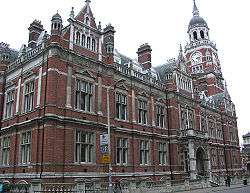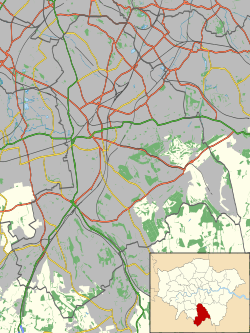Croydon Town Hall
Croydon Town Hall is a council building serving as headquarters for Croydon London Borough Council.[1] It is a Grade II listed building.[2]
| Croydon Town Hall | |
|---|---|
 Croydon Town Hall | |
| Location | Katharine Street, Croydon |
| Coordinates | 51.37223°N 0.09896°W |
| Built | 1896 |
| Architect | Charles Henman |
| Architectural style(s) | Victorian style |
Listed Building – Grade II | |
| Designated | 19 November 1973 |
| Reference no. | 1188798 |
 Shown in Croydon | |
History
Croydon has had three town hall buildings in its history. The first was built in either 1566 or 1609,[1] and pulled down in 1807.[3] A replacement was built on the High Street in 1808[3] to a plan by Samuel Pepys Cockerell,[4] and was demolished as part of the town's High Street widening scheme in the 1880s.[5]
The third town hall building was previously the site of Central Croydon railway station, which was redeveloped for council use in 1895, as part of a plan to install "Municipal Offices, Courts, a Police Station, Library and many other public purposes and yet leave a considerable margin of land which might be disposed of".[1] The building, which was designed by Charles Henman in the Victorian style and built in red brick by Messrs. W.H. Lascelles & Co, was opened by the Prince of Wales (afterwards Edward VII) in 1896.[1]
A statue of Queen Victoria outside the town hall, which was sculpted by Francis John Williamson, was erected in 1903.[6]
It was established as the headquarters of the County Borough of Croydon and went to become the headquarters of the enlarged London Borough of Croydon on its formation in 1965.[7]
The building has been extensively renovated since the mid-1980s,[1] and connects to Croydon Clocktower and the David Lean Cinema (which is in the clocktower).[8]
The council secured additional space for its staff nearby in Taberner House in 1967[9] and in Bernard Weatherill House from 2013.[10]
References
- "Town Hall". 8 April 2014. Retrieved 16 September 2017.
- Historic England. "Municipal Buildings, comprising the clock tower, public library, and Corn Exchange, and including the area balustrade which incorporates a war memorial and a statue of Queen Victoria (1188798)". National Heritage List for England. Retrieved 5 April 2020.
- Brayley, Edward Wedlake; Britton, John (17 September 2017). "A topographical history of Surrey, by E.W. Brayley assisted by J. Britton and E.W. Brayley, jun. The geological section by G. Mantell" – via Google Books.
- Anderson, John Corbet (17 September 1882). A Short Chronicle Concerning the Parish of Croydon in the County of Surrey. Ballantyne, Hanson and Company – via Internet Archive.
croydon town hall.
- "London's Town Halls". Historic England. p. 42. Retrieved 25 April 2020.
- "Statue: Queen Victoria statue - Croydon". London Remembers. Retrieved 5 April 2020.
- "Local Government Act 1963". Legislation.gov.uk. Retrieved 25 April 2020.
- "David Lean Cinema returns to Croydon Clocktower Auditorium". East London Lines. Retrieved 5 April 2020.
- "Taberner House, London". Skyscraper News. Retrieved 23 April 2020.
- "Bernard Weatherill House". Open House London. Retrieved 23 April 2020.
